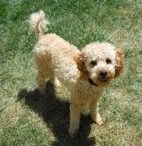 Cherry eye in dogs is the layman’s term for prolapse of the gland of the nictitating membrane. In this condition, the protruding mass in the third eyelid is swollen and irritated. It is a pink bulging mass in the corner of your dog’s eye. This is not a life threatening condition but if left untreated, it may cause dog eye infection and other dog eye problems.
Cherry eye in dogs is the layman’s term for prolapse of the gland of the nictitating membrane. In this condition, the protruding mass in the third eyelid is swollen and irritated. It is a pink bulging mass in the corner of your dog’s eye. This is not a life threatening condition but if left untreated, it may cause dog eye infection and other dog eye problems.
Caused by the weakening of the fibrous tissues that holds the third eyelid, cherry eye in dogs is characterized by the bulging out of the tear glands, making the nasty looking red mass. Though not certain, it is believed that this condition is genetic.
Cherry eyes are very common to some dog breeds like the Beagle, Bulldog, Cane Corso, Cocker Spaniel, Neapolitan Mastiff, and Weimaraner. Poodles are also not excluded, for although they are not included in the above list, they are runner ups in this eye problem as this condition is also common among small dog breeds.
This eye condition sometimes appears quite suddenly. Your poodle may be normal today but the cherry eye might pop out the next day. Dirty eyes might not be the real reason for this condition.
However, it is still best to take regular care of your pet’s eyes. Different breeds may have varied eye structure; it might have narrow tear ducts or droopy eyelids. However, as long as you follow the basic steps, you should have no problems.
Being careful in cleaning is important because improper eye care might lead to eye infections in dogs and scarring that might be a problem later. Clean your dog’s eyes with cotton swabs or baby wipes. Do not use rough materials because it might irritate the dog’s eyes and simple irritations can cause complicated infections.
When your dog has this eye problem, do not hesitate to see a veterinarian immediately. Dog health is very important. Prolonging the treatment may only cause further damage and even hamper your dog’s sight. The best course to treat Cherry eye in dogs is often surgery. It is a safe and easy procedure, but of course, it may be quite expensive. If you have obtained pet insurance, then surgery for cherry eye should be included in the coverage.
There are some dog owners however who look for remedies themselves in order to treat this eye illness. Some dog owners have tried massaging the bulging area back to the original position. Massages should be very gentle so as not to cause irritations, but such a procedure can still lead to further complications.
Thus, it is always wise to seek professional help rather than taking the risk of causing further damage to your dog’s vital organ. The vet will help push the bulging gland back to its place. Some vets would prefer to remove the gland but it is generally not advisable. If the glands are removed, the dogs are at greater risk of having dry eyes. The removal of the third eyelid should be done only if there is no other choice. If the bulging part is removed, complications may arise as the dog gets older.
Cherry eye in dogs can also be treated with eye drops and ointments that are available for those who prefer not to undertake surgery. However, the first step should always be to seek the aid of a veterinarian. Do not put your dog’s health at risk by neglecting this condition. Also, just to be safe, monitor the other eye for it will likely develop cherry eyes too.
Be vigilant with your dog’s health issues. Dogs are family members so we should take care of their health always.


